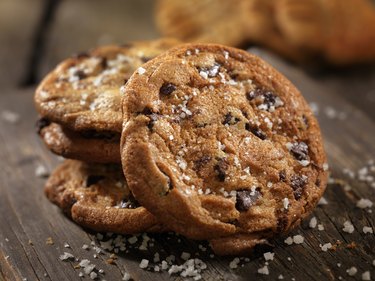
You're reading through your favorite pumpkin muffin or chocolate-chip cookie recipe, checking to make sure you have everything you need when you stumble across one ingredient that leaves you stumped: salt. You're making a deliciously sweet baked good — so what is salt doing in the ingredients list?
Salt actually has many functions when it comes to baking — especially enhancing the sweetness of your homemade treat. (That's why fudgy brownies and chocolate chip cookies sometimes come with sea salt on top!)
Video of the Day
Video of the Day
We tapped Le Cordon Bleu culinary-trained chef and dietitian and Anthony Crifase, LDN, CISSN, to help explain how this works and how to replicate the goodness at home.
How Salt Adds Major Flavor Dimension
"There are five tastes that exist: sweet, salty, bitter, sour and umami (savory)," Crifase says. "When you have something that is only salty, but you add sweetness to it with something like sugar, the saltiness will become more pronounced on your taste buds."
Certain flavors, such as sweet and salty, go hand-in-hand and complement each other when combined. "The balancing of flavors is an art form," Crifase says.
A good example of this is kettle corn: Salted popcorn is salty on its own but adding sweetness provides a flavorful balance, changing the way you taste the saltiness of the popcorn.
"Just think of a time when you added salt to your steak or to the rim of a margarita and how the flavor of that cut of meat or cocktail instantly enhanced. The same goes for a baked good such as a muffin or banana bread — a little salt can be added, even on top, for not only a texture addition but to also help balance the sweetness."
Salt is important to add inside the baked goods (when mixing the dough) as it is on top of them. Both add flavor and texture, but when it's placed on top, the salt will immediately stimulate the taste buds.
Salt Can Also Help Baked Goods Hold Their Structure
Aside from enhancing the flavors of the ingredients in your recipe and balancing the overall sweetness, salt has another very important function when it comes to baking: “It depends on what you’re baking but salt tightens up the gluten structure of the baked product (if you are using gluten!) and even slows down the progression of yeast activity,” Crifase says. This helps prevent your dough from becoming too sticky and helps the final product develop that coveted fluffy texture.
Salt is crucial when it comes to baked goods — so don't skip it!
Which Type of Salt Is Best?
There are so many different types of salt — from kosher salt to sea salt to pink Himalayan — so what do you use when your cookie or muffin recipe calls for a half-teaspoon of the stuff?
Well, it all depends on when you're adding the salt.
What to use in the dough: "For baking, generally, you want a finer grain salt, which is easier to disperse into ingredients and create a better-homogenized product," Crifase says. "If you add large sea salt grains to your baked good's dough, you might end up having one part of the baked product saltier than the rest." And that's something we can all agree isn't desirable.
What to use to sprinkle on top: However, heavier grains of salt come in handy when you're sprinkling them salt on top of your baked goods. Using a coarse salt such as pink Himalayan salt or kosher salt will give you that direct flavor hit to your taste buds.
Tip
For a pop of color, sprinkle pink Himalayan salt atop your baked goods. (Fun fact: The rosy-hued salt gets its color from iron oxide, aka rust.)
What to Do if You’re Watching Your Sodium Intake
Most of us should be cutting down on our sodium intake: The current recommendations say to limit sodium intake to less than 2,300 milligrams per day, but, on average, we're taking in 3,400 milligrams a day, according to the Food and Drug Administration. And if you have prehypertension or hypertension (high blood pressure), then you should limit to 1,500 milligrams per day.
We understand any concern you might have about adding salt to your baked goods — but the truth is, the majority of our sodium intake (71 percent) comes from processed and restaurant foods. In fact, home cooking only accounts for six percent of our sodium intake, per the Centers for Disease Control and Prevention.
To break it down even further, recipes for treats like cookies or muffins typically call for a half-teaspoon of salt while the recipe typically yields a dozen servings. That means you'll only get around 93 milligrams of sodium per cookie or muffin from the added salt, which comes out to just 4 percent of your daily recommended value.
But if you still want to limit your salt intake, there are a few things you can try when baking breads, cookies, muffins and the like:
- Sprinkle salt on top of your baked good to finish it off rather than mixing it into the batter.
- Use reduced-sodium baking powder.
- Use unsalted butter (which the recipe will likely call for anyway).
- Try using half of the salt the recipe calls for or you can cut it altogether, especially if you're using baking soda, which is high in sodium.
Read more: 10 Effortless Ways to Finally Cut Down on Salt